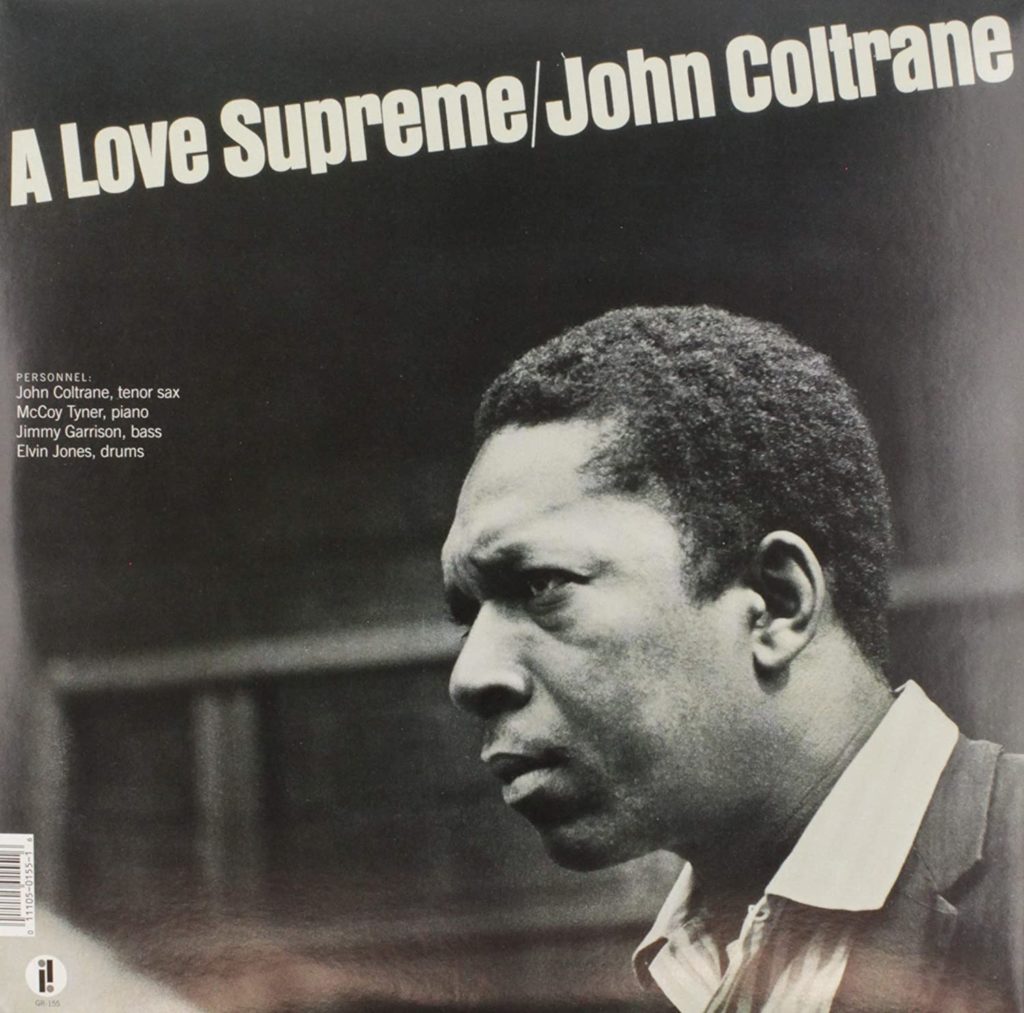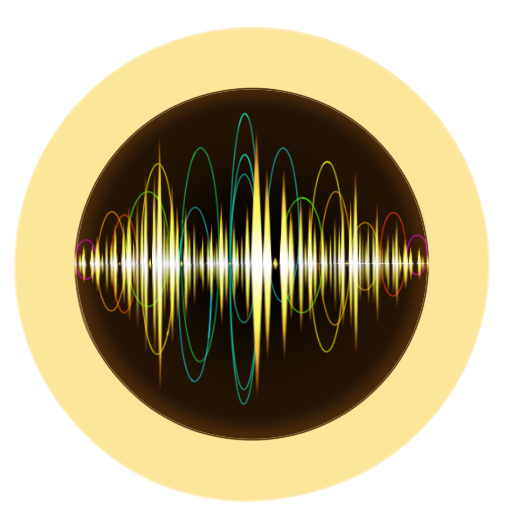The History and Popular Music of the ’60s class learned about John Coltrane’s classic album, A Love Supreme (1965). Here are their reactions.
Lily Brooks:
What made John Coltrane’s A Love Supreme so impactful for me, was not particularly the music, but the complex and rich backstory. Coltrane was an inspirational musician. He overcame addiction, he was a father, a husband and influenced generations with his playing. I personally don’t quite get his music, or most jazz for that matter, which is okay because I can still appreciate it. His music had the ability to transport himself and anyone who listened to another world. He continued to stretch the limits of jazz and was honorably never satisfied with the feeling of comfort. Bill Clinton even mentioned that he went through more transitional phases with his music than Michelangelo did in 50 years with his paintings.
A Love Supreme was made in isolation and paid tribute to God. You can hear the different musicians in the quartet talking to each other with their instruments, still allowing them to have the spotlight and go off into their own world. Watching videos of the quartet performing live is even more invigorating because you can see the passion and excitement with every note they play. In some clips, I could see steam rising from the heads of the musicians. The stable melodies are what really bring the songs back to reality and allows for a somewhat digestible track. I cannot connect to this music personally, and I don’t think I would listen to it again, but knowing what led to the album, and what came after it inspires me. Coltrane made the conscious choice to go cold turkey with drugs and alcohol because he could see his career slipping away. After being kicked out of Miles Davis’ band, he could either chose the path of no return or fight for a chance at redemption. Thankfully, he decided to take his life back. John Coltrane led the evolution for jazz and was a truly amazing jazz player with an even more amazing story, and A Love Supreme is an example of this.
Alex Skiles:
In the liner notes for A Love Supreme, John Coltrane makes numerous references to vibrations that lead back to God. In the documentary Chasing Trane, someone describes Trane’s music as “the brightest light you can hear.” This idea really stuck with me, and the only thing that I know about divinity is that it’s bright, so I wanted to draw something with bright colors and vibrations. These vibrations are inside the circular mouth of a saxophone. It’s all about the vibrations, man!
Conor McGeady:
A Love Supreme by John Coltrane is an incredibly well-known jazz record, and remains to be one of the most popular jazz albums of all time. If you simply search “most popular jazz albums” on Google, A Love Supreme is beaten only by the likes of Kind of Blue by Miles Davis, which really says something. The album radiates a very energetic but somewhat structured and simplistic sound, due to the fact that it was performed in a quartet, in contrast to a lot of experimental jazz albums such as Out to Lunch! by Eric Dolphy and Black Saint and the Sinner Lady by Charles Mingus. A Love Supreme is an extremely important record in the history of jazz, as well as in John Coltrane’s legacy.
When looking into the history and life of John Coltrane while he was writing this album, you’d find that there’s a massive underlying motivation behind the creation of the record, which was Coltrane’s relationship with a higher power. Not necessarily God, as told in the Christian Bible or any other sacred texts, but simply a higher being in the universe. John Coltrane was almost obsessed with his idea of this higher power, and came to express it through his music. Although these feelings may not be abundantly clear while only listening to the music, the underlying tones of spirituality reek through the album, if the listener is aware of the motives behind the album. Even the titles of the tracks are hints towards topics such as a higher power.
The record consists of four tracks, all of which possessing contrasting tones to each other. The first track, “Acknowledgement,” (title relating to the spiritual motivation) starts the album off with an emphasized “swing” feel, with unorthodox drums consisting of a lot of unique timings when hitting the snare and ride cymbal, giving the track a sporadic energy. Coltrane, on the saxophone (tenor and soprano), solos for almost the entire track, as if telling a story of his acknowledgement of a higher power, and how he felt during those moments.
The second track, “Resolution, is slightly more structured and slightly slower, emitting a sort of calmer but still exciting energy. The rhythmic drums continue in this track, although they are much less erratic than on the first track, but are still fast on the ride hits, giving constant energy. I’d like to think that in this track, Coltrane finds his conclusion with his spiritual searchings, and begins to live a different, better life thanks to his realization.
The third track, “Pursuance,” is the longest song on the album, reaching over 10 minutes long. The track opens with a minute and a half drum solo, and the lively feel of the drums relate well to the title, pursuance, for maybe Coltrane is pursuing his new spiritual life, as well as his relationship with this higher power he’s given in to. The pianist, McCoy Tyner, really shines on this track, with a fabulous, spirited solo about one fourth into the track. Due to the simplicity of the instrumentation in a quartet, it really allows for each musician to shine without any others clouding their talent.
The fourth and final song on A Love Supreme is “Psalm,” a much slower and delicate track compared to the energy of the songs that precede it. The drums are much more dialed back, allowing the tack to really focus on John Coltrane’s expression through his saxophone. This track is quite different tonally from the rest of the record, and as such has a slightly different topic than the rest. The song, according to Coltrane, is about civil rights, and more specifically, the four little girls who were tragically bombed in 1963 at the 16th Street Baptist Church in Birmingham, Alabama. This horrific event motivated Coltrane to write a song to help cope with his emotions as well as give others going through the same pain as him something to listen to.
Overall, A Love Supreme is the definition of a casual jazz album, it has both smooth and energetic tracks, and has a theme of spirituality that’s incredibly fun to listen to. If you need something to play in the background, or even if you just want to relax to some instrumental music, A Love Supreme will definitely satisfy you.
Pritam Khalsa:
For my response to A Love Supreme (1965), I drew a saxophone with planets. When we watched Chasing Trane—a documentary about John Coltrane’s life and music—many of the people discussing him mentioned that different people could listen to his music and still feel like they understood it. He also tried to learn more about different cultures and religions and incorporate those into his thinking. He was a very peaceful person and cared about bringing people together. Because he cared so much about other cultures and many different people all connected to his music, I decided to draw his saxophone as if the whole solar system was coming out of it instead of music to show the connection.
Gibson McCoy:
Knowing about an artist’s personal life/life beyond the music can sometimes change opinions that we have on artists whether that be good or bad. There was a lot that I didn’t know about John Coltrane. The extent of my knowledge about him was that he played the saxophone and died at a young age. To learn about who Coltrane was and what he went through before A Love Supreme enhanced and maybe changed how I looked at the album and what a work of art it is.
Before watching Chasing Trane (documentary) I was a little bit confused about what the album’s purpose was and what emotion was supposed to be heard through the album. I have never been a big jazz person and 95% of the time when I listen to jazz music and the songs have a deep meaning I can’t easily come to the conclusion of what the meaning is or what it’s supposed to be. Of course with other peoples already formed ideas I slowly can piece it together and find what the musician is saying through their music but it might not be what the artist intended. Personally learning about what happened to Coltrane when he was a child helped me realize the full potential and theme of the album.
Losing any sort of parent figure let alone, four of them in the span of only two years is tremendously hard on a child who is only 12 and in the prime learning years. He said so himself that he found his passion for music after the passing of his two grandfathers, grandma and dad. The purpose of the album for Coltrane was a spiritual awakening and thanks to God, something that I would have never picked up on. Previously touring with Miles Davis he fell into drugs and this awakening happened after getting kicked out in 1957 for being unprofessional. He quit drugs cold turkey but it was not 1965 that he released A Love Supreme. What happened after getting kicked out is arguably what he is most known for musically. The album for him is thanks for letting me live and continue on this path and have a family, again something that is not easily recognizable. Before learning more about Coltrane I did find curious why he was thanking God. The documentary taught me about his childhood and his previous problem with drugs. This lesson taught me to be more open-minded and knowing about his childhood with his grandfathers being ministers, I was able to add more understanding of why he was thanking God, and also really just the albums importance to Coltrane which is what makes it amazing.
Sam Swartley:
John Coltrane mastered his craft as a musician by playing with the masters. There is no better way to learn the ins and outs of jazz than by playing with people. Coltrane was always chasing, always learning everything he possibly could from anyone in order to understand how to express himself within his own music. Playing with Dizzy Gillespie in the beginning of his career and later playing with Thelonius Monk both indescribably amazing musicians. What really launched Coltrane off was playing with Miles Davis, more specifically on Kind of Blue. I view that record not as a Miles Davis record, which it is and he definitely shaped the sound of that record, but Bill Evans, Cannonball Adderley, Jimmy Cobb and, of course, Coltrane really show how jazz isn’t always just one person’s version. That record not only was labeled as the best jazz record of all time, but put Coltrane in a new place. This led to him creating Giant Steps which was all his original compositions. This showed where Coltrane was at personally during the late 50s/60s, allowing him to see what he could do with his music, and that it was time to move on from playing with Miles.
Coltrane, like everyone, had a lot of questions about religion, life and death. The way he views the world is very inspiring to me, he found a way to use music to not be afraid of the unknown, he used music as a tool to navigate through the universe. The title to the documentary we watch Chasing Trane could have meant just following the history of John Coltrane, but an interesting way to interrupt it is Coltrane chasing his feelings, emotions and unknowns within his life and spreading it to others, allowing everyone to have an understanding of the world like the artist does.
Coltrane wasn’t just a musician. He used music as his way to find and understand himself. Einstein was one of Coltrane’s biggest inspirations. I bet you’re asking; how does John Coltrane learn a single thing from a theoretical physicist? Well, Einstein was a very intelligent thinker, how he viewed the world was similar to how John Coltrane did, and he absorbed this into his music. Here’s an example, in the title track of
Giant Steps Coltrane took a very musician and scientific approach, by looking at the circle of fifths and creating patterns within the key changes of the song (look at this YouTube link its really cool and pretty easy to unders
tand https://www.youtube.com/watch?v=62tIvfP9A2w&vl=tr). Coltrane’s analysis of jazz harmony was like no other, and pushed the genre in a whole new direction.

This is part of how the key changes in Giants Steps, this shows how the key changes in the biggest ways possible, relating to the title. This is why this tune is so challenging, jumping from the key G to B is really hard because of the amount of notes that are different in those to keys (G: G, A, B, C, D, F#. B: B C# D# E F# G# A#). Coltrane created these jumps in emotion every two bars or so, which gives this racing feeling. This is a very theory heavy example of how John viewed music composition in the early 60s, and let me tell you it only gets better.
A Love Supreme took jazz music somewhere else. As a whole, the record is one big beautiful project. I will talk about each track and show how each one flows into the next, showing how A Love Supreme isn’t just your average jazz record. It’s Coltrane’s way of connecting to the world, allowing us as an audience to also understand the meaning of our own lives.
A Love Supreme, Pt I – Acknowledgement
That opening line. Gives me the chills every time, and there’s this feeling of excitement anticipation of the bass line everyone should know by heart. This bass line melody is repeated spiritually throughout the entire collection. John Coltrane’s melody on top of that works around the same melodic ideas but pushing outside. Coltrane intertwines that groundbreaking melody into his solo, but in his solo if you really pay attention can hear him play it in all 12 keys. Relating back to Giant Steps, this shows how Coltrane wants to explore each and every emotion that can possibly be expressed, once again pushing the limits of jazz harmony. Also you notice that the band might not necessarily change keys with Coltrane, creating tension. After Coltrane’s world-changing solo, you hear his calm voice. This is probably the only time you’ll ever hear it, Coltrane is a quiet guy, lets the music do the talking. The tune wraps up perfectly with the bass soloing the most spiritual line of jazz music.
A Love Supreme, Pt II – Resolution
Jimmy Garrison once again setting up the tune perfectly, with a bass line that has us sitting on the edge of our seats. When the band comes in, you almost feel on edge. John’s tone is at the breaking point of “shrillness” but not quite getting there. This melody is also one of my favorites, you feel the rush and business of life as a whole. Then McCoy Tyner takes us on a journey. Really showcasing his musicianship. Tyner takes inspiration from Coltrane and really highlights the chord changes along with staying true to his own personal sound. This tune overall just feels like it’s pushing you, inspiring you, taking you to a place where you can be yourself and accomplish what you really want within your life. Coltrane’s solo hits right back, keeping that tone that almost makes you feel anxious, but not quite… implementing that first melody again. Pulling the tune together with making the overall vibe more and more chaotic before returning home to the main melody.
A Love Supreme, Pt III – Pursuance
Now Elvin Jones has something to say. One of the best drummers of all time has this loose time feeling that just is one of a kind. Again just pushing us to want to hear more and more. Coltrane comes in with a melody that you haven’t heard up till this point, yet it sounds so familiar, which I think everyone can relate to in some way. McCoy’s solo this time is different, faster, packing more and more notes in. This is probably my favorite piano solo on the record, just because of how aware the band is and how Tyner is pushing everyone. Also it’s cool to think about how Coltrane, this being his personal project, still allowed every member of the quintet to have a chance to unleash their musicality. Coltrane’s solo of course is fast paced, leaving the key of the song and always finding his way back home. What fascinates me about Coltrane is all the different sounds he gets out of his horn, it’s so one of a kind and blows my mind. Jones hits us with a very long dragged out fill that then goes into Garrison’s complete solo that lasts the entire last two minutes of the tune. At this moment you can once again hear that melody from Acknowledgement along with Garrison’s own twist. There is always something beautiful about a bass player playing completely by himself. His dark edgy chords he creates with the lower tones not only captures that sound Coltrane is chasing, but also the angst of the ’60s. Garrison’s last few lines stood out to me because of how important and brave they sound, allowing him to confidently end and finish the tune.
A Love Supreme, Pt IV – Psalm
This song seems to be more on the sorrowful side of things, you can hear it right away as Coltrane’s tearful sax line takes you off to a different world. Reminding us that yes, the world isn’t all good and that there are some evils that need to be dealt with within everyone’s lives. This song directly relates to another one of John Coltrane’s tunes, Alabama. Which was dedicated to the church bombing on 13th street. As I listened to this song I looked up “church bombing on 13th street” to make sure I was getting the facts right. First thing that came up was an image of four little harmless girls on the screen staring back at me. The emotion and feeling you get from that was a lot, and I think Coltrane’s way of expressing the emotions he was feeling allowed me to understand what I am feeling about this sadness in the ’60s. In a way, Coltrane is crying through his saxophone. He always hated violence. It felt like Coltrane was just asking why? Why and how would someone think it necessary to bomb a church because of the color of a community’s skin? This tune ends exactly like the record started, with the opening line of Acknowledgement. I think everything in life should end how it started, but with a new understanding, which Coltrane showcased perfectly.
The only person that will ever fully understand this album is John Coltrane, it was his prize possession. It showed his kindness, support and understanding of the universe. Personally, this album has become a spiritual listening for me, it inspires and allows me to move forward as a human myself. A Love Supreme is the answer to everything, music is the answer to everything.
Just love this record. Never went as in depth on it and it made me love it even more! And just John Coltrane as a musician there is a lot I haven’t discovered yet.







These are wonderfully written and insightful. Appropriate for this greatest of all jazz LPs. For me, this album was life-changing. Coltrane’s spiritual gift to G-D. His playing conveys more than all the words found in a Funk and Wagnalls. Great choice. I hope these students return to this album repeatedly for inspiration and solace.